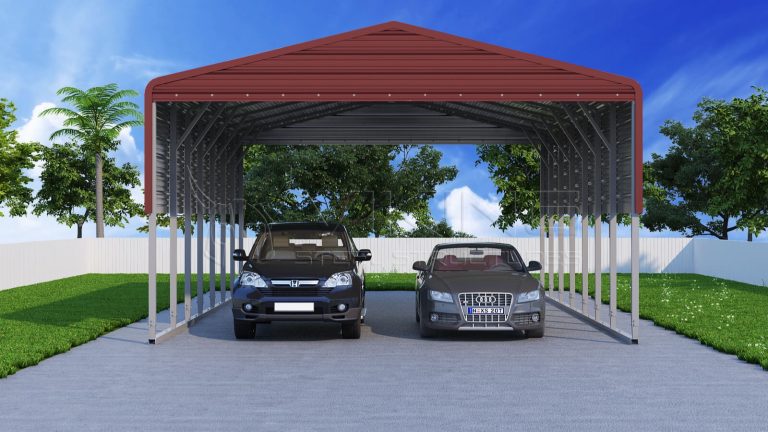How to Convert a Carport into a Fully Enclosed Metal Garage?

A carport is a simple and open structure. It protects your vehicle from scorching sunlight, heat, and falling timber. Is this all you need to protect your vehicle or items? Well, this is an economical option, but it has limitations when it comes to fully protecting your vehicles. The garage provides full protection from the elements but costs more than a carport.
If your needs for a space have grown, but you don't want to buy a new structure to meet them, consider converting the existing one. Transform a carport into a fully enclosed metal garage that effectively accommodates your growing needs.
However, some questions can overwhelm your mind before making this decision. Would it be costlier to convert than actually buy a new steel garage? How long will it take to convert? Do I need an expert's help, or do it myself? We are here to help you release your stress, not only with information but also with the right solutions.
What Is a Metal Carport?
Before moving ahead, you should put your best foot forward by understanding exactly what a carport is. A metal carport is a simple, roofed structure supported by steel posts. It usually has open sides. This structure is installed faster than other steel structures in most cases.
A steel carport is ideal for:
-
Parking cars, trucks, or bikes
-
Providing shade
-
Keeping snow, rain, and sun off your vehicle
Despite being a simple structure, it's popular among many boat, RV, and vehicle owners. They are budget-friendly, quick to install, and low maintenance. But they do have some limitations.
Limitations of a Metal Carport that Drive You to Convert It
A metal carport is an open structure that is good if you have basic needs for a space and storage. But as your needs outgrow the structure, you need to make a decision: either transform the existing structure or install a new one.
Let’s explore the limitations of a carport that has insisted you read this blog for a solution.
-
Lack of security: Open sides mean anyone can access your vehicle or tools. Often, you notice scratches on your vehicle, which ruin the look of your expensive car.
-
Limited weather protection: A carport can’t protect your vehicles from heavy rain, storms, snowfall, and tornadoes, but a garage can. It is because the structure is enclosed. Wind, snow, and sideways rain can reach inside very easily.
-
No insulation: Since there are no walls and enclosed spaces, you can't opt for insulation. You can't control the temperature, like unbearable warmth in the summers, or chilled weather of winter months, to harm your vehicles.
-
Lower resale value: Well, carports do add value to a home and increase resale value, but not as much as a garage. If potential buyers are looking for an enclosed space to protect their vehicles fully, they might not be interested in your property.
These downsides often push homeowners to convert a carport into a garage. You can do it easily if you follow the right steps. But is it worth converting a carport? Let's quickly analyze this in the next section.
Is It Worth Converting a Carport?
Consider the pros and cons outlined below. It will help you analyze whether to convert a carport.
Pros:
-
Cheaper than building a new garage from scratch
-
Adds security and functionality
-
Can boost your property's resale value
-
Keeps items safe from theft and damage
Cons:
-
May need permits or zoning approval
-
You need a solid existing carport structure
-
Requires time and professional installation
For most people, it's a worthwhile investment, even better than investing in a new garage.
How to Convert a Carport into a Garage [Easy steps]
Converting a carport into a garage might seem difficult at once. But it's not if conducted with complete focus and the right steps. Here they are.
Step 1: Check Local Building Codes
It should be the first step because even if you are not installing a new structure, some local building codes still apply to certain properties. Therefore, contact your local building department and inquire about the rules and regulations applicable if you make changes to the existing structure.
You may need permits or be required to follow zoning laws, especially if you are adding walls, insulation, or electrical components.
Step 2: Inspect the Current Carport
Inspect the condition of your current carport. If it's too old, it's better to install a new prefabricated garage, as a weak structure can't withstand changes to it. Moreover, not all carports can handle the extra weight of walls and doors. Make sure your existing structure:
-
Has a solid steel frame
-
Is anchored properly
-
It is level and in good condition
Step 3: Choose the Wall Material
Partner with a top metal building dealer and instruct them to select the highest-quality material for converting a carport. The best gauge steel components make your garage weather-resistant, low-maintenance, and easy to insulate. One more thing you should not miss: checking the foundation of the structure. The stronger the foundation, the easier it is to install thick walls.
Step 4: Install Walls and Siding
Carport conversion is mainly for walls and siding because this is what it didn't have in the first place. After adding walls and a roof, it begins to look like an enclosed space. However, it's not as easy as it seems because installers must consider certain standards before installation.
You have to consider the following points:
-
Add side panels first
-
Install back wall panel
-
Attach any windows or vents
This is usually done with screws and brackets provided by your metal building provider.
Step 5: Add a Garage Door
With a door, a garage becomes a convenient space to put things inside. Moreover, this feature ensures protection from mischievous activities. You can choose from different types of doors, like roll-up or sectional garage doors, depending on your needs and space. But measure the door carefully so it fits your opening and matches the style of the structure.
Also, don’t forget to include a walk-in door if you want easy access without opening the big door every time. So, the type, size, and total number of garage doors depend on how you want to use the converted carport.
Step 6: Insulate the Structure
Well, insulation is optional, but it's one of the reasons you are converting the carport. That's why it's at the 6th step. Insulation helps you control temperature, prevent condensation, and reduce noise. Its types depend on what are you going to store? Do the stored items need temperature control? Are stored products perishable? Answers to these questions will help you find the best insulation type that is also within your budget.
Insulation types to choose for your garage:
-
Single bubble
-
Double bubble
-
Woven R-17
-
Foam board
-
Spray foam
-
Reflective insulation
Step 7: Add Finishing Touches
Once the construction and installation part is done, you can think of working on its interior. Now you can customize the garage to suit your needs. This is one of the crucial steps because it helps to make the space truly yours. During the finishing touch, you can also check for any flaws in the structure and ask the dealer to fix them. If they offer a warranty, it will cost you nothing.
Here is how to add the finishing touches:
-
Add shelves or cabinets
-
Install lighting and electrical outlets
-
Paint or decorate the interior
Costs Involved in the Conversion
If the cost involved in the conversion is more than the cost of a new garage for the same customization, then it would not be a smart choice. So, whether it's a smart decision or not, you can know it only by comparing costs.
While prices vary depending on size and features, here’s a general breakdown:
|
Item |
Estimated cost |
|
Side and back walls |
$1000 – $1500 |
|
Garage Door |
$800 – $2,500 |
|
Walk-in Door |
$200-$600 |
|
Insulation |
$800 – $1000 |
|
Labor |
$500 – $1000 |
Total: $2,300 to $6,600, depending on what you need.
This is still cheaper than building a new garage, which can cost $4,000 to $15,000 and even more than that. However, remember that the cost of features varies based on country, region, purpose, and dealer.
Things to Keep in Mind
Before you jump in, here are some quick tips. These tips will stop you from making mistakes that most people make while converting a carport.
-
Get permits early: Don't start without local approval.
-
Work with a pro: If you are unsure about installing walls or garage doors, hire an experienced installer.
-
Check for warranty: Find out if dealers offer upgrade options or warranties.
-
Plan for drainage: Ensure the new garage is well-drained to prevent flooding issues.
A Top Dealer for Customized Steel Carports
If you do not want to convert an existing carport, install a customized one with the help of our team. Find the most suitable type of carport for your needs on our website and customize it using our 3D estimator tool. You can also consider buying a fully enclosed garage instead of converting the existing carport if it's time-consuming for you. Share your requirements with our experts at 877-801-3263, and we will bring your vision to life. Whether you want a carport, garage, barn, RV cover, or even a commercial structure, we have got you covered.

Looking for a metal building that fits your needs?




